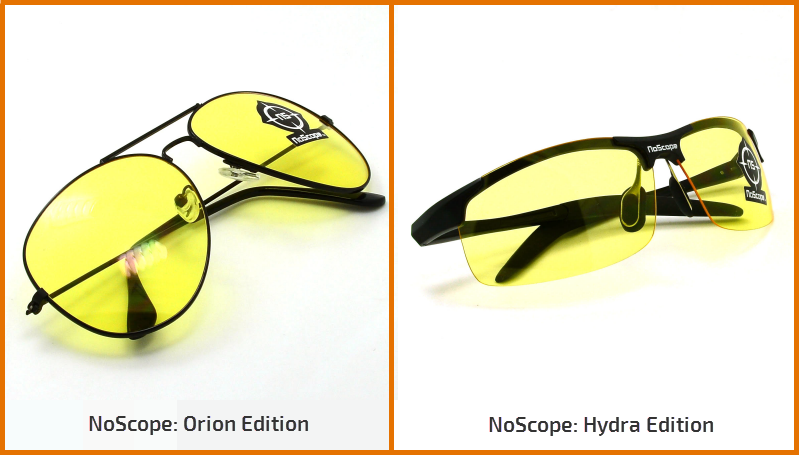NoScope Gaming Glasses Second Generation: Review
In-Depth Look at the Latest Editions to the NoScope Family

Last April, Player Theory tackled the problem of eye strain with our review of the original pair of NoScope gaming glasses, a low-cost competitor to the now-infamous Gunnars, which run for as low as $69, a figure that quickly rises if you want prescription lenses, modifications, or just a different frame than the basic model offers.
NoScope attempted to address the price point issue last April with a pair of plastic-rimmed frames that ran players a low $19.99 before tax. When Player Theory tested them out earlier in the year, we generally found them favorable in spite of issues like “glasses on glasses” and the length of time required before we noticed their usefulness. However, today marks the launch of two additional frames:
- Orion: Aviator-style frames with metal rims that extend the full length of the glasses.
- Hydra: An upgrade to the previous pair with stronger, metal-infused temples for stronger support.
How will these models stack up to the original NoScope "Demon" model?

Context
I work from home. I am primarily a PC gamer. That means I work where I game, staring at the same monitors well past the end of my eight-hour workday. I don’t think NoScope had any idea when they sent us their product last April, but I am eye strain epitomized. They’re often dry, and they hurt. I look for any and all ways to improve my comfort while at my desk, so I wanted to try the new models out.
Comfort and Style
Between the two models, I preferred the upgraded Hydra for the sake of comfort. As I mentioned in April, I have a fairly small face with a pair of prescription frames (19”), so the openness of the frame design allowed the space I needed for the Hydra frames to fit neatly on top. They were a little big for my face, but I recognize that my size as a person is an outlier, not the norm. Without my glasses on, they fit a lot better; the nose guards and the temples rested comfortably against my face and skull. If I wasn’t completely bat-level blind without my prescriptions on, I’d be completely sold on comfort alone.
The Orion rested lower on my face, but they are still a comfortable fit. Personally, I’m not a fan of the frame design. After showcasing a picture of myself wearing the glasses to my “World of Warcraft” raid group, one raider said I looked like his mom (who was “very pretty”) and another said I looked like a grandparent. Whether the moms of 15 year olds are pretty aside, that’s not the look I’m hoping to achieve as a 27 year old hipster (or is it?). However, they too were a comfortable fit, albeit less comfortable with my glasses on. As I said, they rested low, but they were large enough to still cover my entire field of vision.

Effectiveness
Something both the new frames did incredibly well in the second generation was hit the problem of depth perception. Both sets had lenses big enough to cover the sides of your face, as well as the immediate frontal cone, so that you had a consistent experience looking straightforward and to the side. I’m frankly a little impressed they corrected this so well between generations.
As in the past, the effectiveness increased as I wore them for increasingly long periods of time. They are not all that useful if you’re only at the computer in short bursts, but that’s not the point of gaming glasses, either – casual use of computing, that is. They highly benefited me after a full day at work or back-to-back matches of “Heroes of the Storm.”
Research
As far as scientific evidence to support the effectiveness, the original article cites research using the North Carolina State University library database (to which I have access as a graduate student), finding no statistically significant improvement for users wearing tinted glasses and users in the control groups from neither the Latvian Journal of Physics and Technical Sciences nor the Ophthalmic and Physiological Optics journals.
Conclusion
There are two things that really sell the glasses for me: the improvement between the first and second generations (e.g., depth perception, adding a secondary set for stylistic preferences), the improved durability by integrating metal into their design, and the way they cover my glasses better. If you already wear glasses, I highly recommend the Hydra model over the Orion pair, but the Orion set does have a classical look about them that screams “the ‘80’s!” if that’s what you’re into.
My hope for the future is a set of prescription frames, although I can see how that would be difficult to accomplish for a fledgling company. We’ll just have to wait and see how this plays out in the future for a company with so much potential.
If you’re not interested in glasses at all, these probably aren’t going to interest you anyway. You can always download flu.x for a free way to alleviate eye strain. However, I highly recommend these glasses, especially considering how low cost they really are.

Source: Latvian Journal of Physics and Technical Sciences: Effect of Yellow Filters on the Vision NoScope Gaming Glasses Ophthalmic and Physiological Optics: Do tinted lenses or filters improve visual performance in low vision? A review of the literature